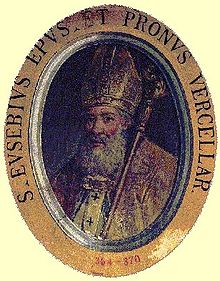Eusebius of Vercelli
Eusebius von Vercelli (* around 283 in Sardinia ; † August 1, 371 in Vercelli ) was the first bishop of Vercelli and was canonized by the Catholic Church. In the Arianism dispute of the 4th century he supported Athanasius .
Live and act
Eusebius was born in Sardinia and received his education in Rome , where he worked as a lecturer. It is believed that Restituta of Cagliari, often equated with Restituta of Africa , was his mother. In 345 he became the first bishop of Vercelli . The community in which the clergy under him lived can be seen as a preliminary stage of monastic life ( vita communis ), as practiced by the Augustinians , for example.
In the Arian disputes of the 4th century, Eusebius was a staunch opponent of Arianism , that is, the teaching of Arius , according to which God and Jesus are not of the same nature . In 353 the Bishop of Rome Liberius commissioned him to join an embassy under Lucifer of Calaris , which was to ask the Emperor Constantius II for a new synod to negotiate Athanasius , who had already been condemned in 353 at the Synod of Arles . At the Council of Milan , which was finally convened in 355, Eusebius was one of the staunch defenders of Athanasius. Even when the emperor threatened harsh punishments for every bishop who refused to sign the condemnation of Athanasius, Eusebius stood firm. So he was sentenced and banished.
Eusebius first came into exile in Scythopolis in Syria , where Bishop Patrophilus , called "prison guard" by Eusebius, treated him cruelly, later to Cappadocia and finally to the Egyptian Thebaïs . Under Emperor Julian , who ruled from 361, he was able to return and take part in the Synod of Alexandria in 362 . Here he was commissioned to take care of the settlement of the Meletian schism in Antioch . He was unsuccessful, however. Nevertheless, Eusebius continued to take action against Arianism in the West. One of his main opponents was Auxentius of Milan . According to legend, Eusebius was stoned to death by the Arians against whom he had sided with.
Aftermath
After his death, Eusebius was canonized . His feast day is August 2nd, before the calendar reform after the 2nd Vatican Council it was December 16th.
Most of Eusebius' writings are lost. Three short letters have been preserved and published ( Jacques Paul Migne , Patrologia Latina XII, 947–954 and X, 713 f.). The Codex Vercellensis in Vercelli Cathedral , a manuscript with the four Gospels, may have been written by Eusebius.
Numerous Eusebius churches are under the patronage of Eusebius von Vercelli; a mural in Vercelli Cathedral shows his portrait.
literature
- Friedrich Wilhelm Bautz : Eusebius of Vercelli. In: Biographisch-Bibliographisches Kirchenlexikon (BBKL). Volume 1, Bautz, Hamm 1975. 2nd, unchanged edition Hamm 1990, ISBN 3-88309-013-1 , Sp. 1568-1569.
- Adolf Jülicher : Eusebios 27 . In: Paulys Realencyclopadie der classischen Antiquity Science (RE). Volume VI, 1, Stuttgart 1907, Sp. 1441-1443.
Web links
- Michael Ott: St. Eusebius . In: Catholic Encyclopedia , Robert Appleton Company, New York 1913.
- Eusebius von Vercelli in the Ecumenical Lexicon of Saints
Remarks
- ↑ Hieronymus , de viris illustribus 90.
- ↑ Restituta on JISKMail
| personal data | |
|---|---|
| SURNAME | Eusebius of Vercelli |
| ALTERNATIVE NAMES | Eusebios of Vercellae |
| BRIEF DESCRIPTION | Bishop of Vercelli (from 340) |
| DATE OF BIRTH | at 283 |
| PLACE OF BIRTH | Sardinia |
| DATE OF DEATH | August 1, 371 |
| Place of death | Vercelli |

